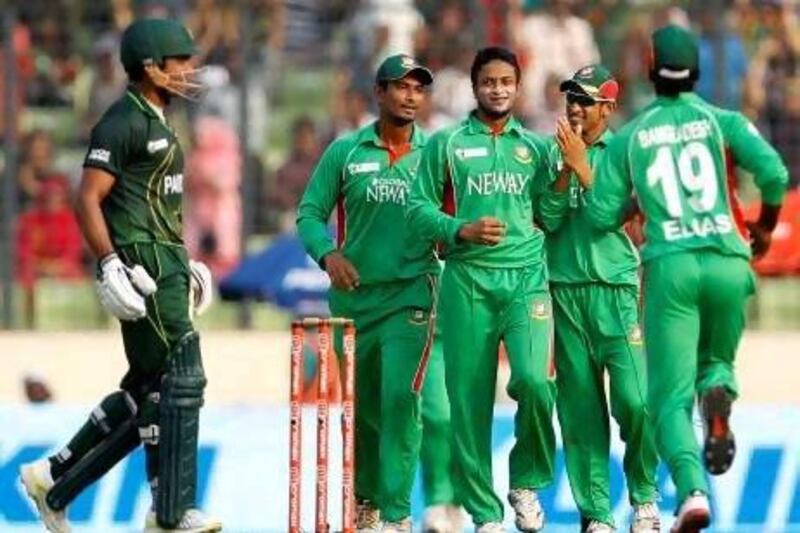With Bangladesh cricket, it is hard to differentiate between sunrise and the false dawn.
Back in 1999, they beat a Pakistan team that would go on to reach the World Cup final. Many viewed that game with suspicious eyes, but for millions of fans back home, it was a landmark day, affirmation that the side belonged at cricket's top table.
Six years later, at Sophia Gardens in Cardiff, Aftab Ahmed smashed a four and a six to upset Australia, after the 20-year-old Mohammad Ashraful had compiled a beautifully paced century.
In their opening match at the 2007 World Cup, a superb spell of pace bowling from Mashrafe Mortaza and some belligerent batting combined to embarrass India.
Less than a month later, they were at it again, routing South Africa by 67 runs on a slow surface in Guyana. The highs could never be sustained though, and the 2007 World Cup epitomised the blow hot-blow cold nature of the performances.
Sri Lanka outclassed them to the tune of 198 runs after that famous victory against India. Success against South Africa was preceded by thrashings by Australia and New Zealand.
In its aftermath, they were comprehensively beaten by Ireland, the other rank outsiders in the Super Eight.
Dav Whatmore, who coached the team during those tumultuous times, was full of praise for his wards after the India game. "The Bangladesh side of two or three years ago might not to be able to overhaul the target of 192 against India. A lot of these boys are willing to work a lot harder out in the middle in difficult periods".
By the end of the tournament, the peaks and troughs had driven him to distraction.
It did not help that the establishment didn't understand the man or his method. When he announced that he wouldn't be renewing his contract and that he was interested in the India job that had opened up following Greg Chappell's exit, the Bangladesh board's chief executive lashed out, suggesting that Whatmore's "Australian way" wasn't a good fit for teams from the region.
"Here in the subcontinent, we're very emotional people and sometimes a player performs depending upon how he feels when he gets out of bed," he said, a stereotypical excuse that chose to ignore Whatmore's World Cup win with Sri Lanka and the transformation of a Bangladesh team that had not won in 47 consecutive matches between 1999 and 2004.
Another Australian is in charge of coaching now. Stuart Law was the first home-grown captain to lead Queensland to Sheffield Shield glory and cricket obsessives will always remember him as the man who averaged infinity – he scored 54 not out in his only Test innings.
Law's tenure – he took over from Jamie Siddons last August – has been no less tempestuous. Test and ODI losses in Zimbabwe resulted in Shakib Al Hasan, the team's best player, losing the captaincy, while Tamim Iqbal, the dashing opener who was one of Wisden's Cricketers of the Year in 2011, was originally only picked as a reserve for the Asia Cup squad.
What Bangladesh did at the tournament was summon up the sort of consistency that has been beyond them before.
They may have lost both their games to Pakistan, but neither was a formality.
At one stage in the opening game, they needed just 39 at a run a ball with five wickets in hand. In the final, they were just a thick outside edge away.
In between, they chased with tremendous composure and skill against both India and Sri Lanka.
Tamim and Shakib both aggregated more than 200 runs, while Mashrafe, Abdur Razzak and Shakib all took six wickets while conceding less than five an over.
It was the sort of combined effort that neither India nor Sri Lanka could produce, and it said much for the change in public mood that many went to the Sher-e-Bangla Stadium for the final expecting the unexpected.
"It [the Asia Cup] will be remembered by fans and the cricketers, who now have a blueprint of teamwork for future reference," wrote Mohammad Isam on Cricinfo. "They have learned how to chase down a big total and how to go for the jugular in a curtailed match."
The Bangladesh Premier League Twenty20 competition, which allowed the country's top players to share a dressing room with limited-overs stalwarts, was clearly a positive, and with their leading players still so young, there's a lot to look forward to.
Shakib has just turned 25. Tamim is 23. Mashrafe, despite a catalogue of injuries, is 28 and has compensated for loss of pace with clever variations.
After the victory against Bermuda in 2007 that allowed the side to qualify for the Super Eight ahead of India, a small band of supporters gathered outside the dressing room to chant: "Is there any team but Bangladesh?"
That refrain might now be directed at India, who haven't invited Bangladesh for a bilateral series or tournament since 1998. Putting one over Big Brother never felt sweeter.
@ For more on BANGLADESH, visit thenational.ae/topics





